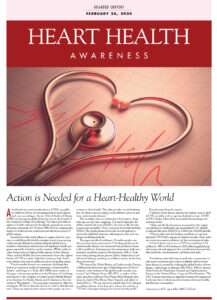2024 Heart Health Awareness More Back issues See E-Edition
Action is Needed for a Heart-Healthy World
A world without cardiovascular disease (CVD) is possible, yet millions of lives are lost prematurely to heart disease each year, according to the new Global Burden of Disease (GBD) special report published late last year in the Journal of the American College of Cardiology. The report provided an update of health estimates for the global, regional and national burden and trends of CVD from 1990-2022 by analyzing the impact of cardiovascular conditions and risk factors across 21 global regions.
Research from this study reflects an urgent need for countries to establish public-health strategies aimed at preventing cardiovascular diseases by underscoring the global action needed to disseminate information and implement health programs, especially in hard-to-reach countries. While cardiovascular disease rates are high globally, regions of Asia, Europe, Africa and the Middle East were estimated to have the highest burden of CVD mortality. High blood pressure, high cholesterol, dietary risks and air pollution remain its leading causes.
“Cardiovascular diseases are a persistent challenge that lead to an enormous number of premature and preventable deaths,” said Gregory A. Roth, MD, MPH, senior author of the paper and associate professor in the Division of Cardiology and director of the Program in Cardiovascular Health Metrics at the Institute for Health Metrics and Evaluation at the University of Washington. “There are many inexpensive, effective treatments. We know what risk factors we need to identify and treat. There are simple healthy choices that people can make to improve their health. This atlas provides detailed information on where countries stand in their efforts to prevent and treat cardiovascular diseases.”
The mortality rates are broken down by location, along with age, sex and time categories. The report identifies disability adjusted life years (DALYs), the years of life lost due to premature mortality (YLLs), and years lived with disability (YLDs). The results presented include several updates to previously published estimates, reflecting new data and new disease modelling methods.
The paper specifically addresses 18 cardiovascular conditions and provides estimates for 15 leading risk factors for cardiovascular disease: environmental (air pollution, household air pollution, lead exposure, low temperature, high temperature), metabolic (systolic blood pressure, LDL-C, body mass index, fasting plasma glucose, kidney dysfunction) and behavioral (dietary, smoking, secondhand smoke, alcohol use, physical activity).
“We formed the Global Burden of Cardiovascular Diseases Collaboration three years ago to help bring state-of-the-art research to the forefront of the global cardiovascular community,” said Valentin Fuster, MD, PhD, an author of the paper, president of Mount Sinai Fuster Heart Hospital, physician-in-chief of The Mount Sinai Hospital, and editor-in-chief of JACC. “We are excited to publish this 2023 Almanac as a dedicated issue of the Journal to inform the realities of CVD risk and inspire strategies for a heart-healthy world.” Key takeaways from the report:
• Ischemic heart disease remains the leading cause of global CVD mortality with an age-standardized rate per 100,000 of 108.8 deaths, followed by intracerebral hemorrhage and ischemic stroke.
• High systolic blood pressure accounted for the largest contribution to attributable age-standardized CVD disability adjusted life years (DALYs) at 2,564.9 per 100,000 globally.
• Dietary risks were the leading contributor to age-standardized CVD DALYs among the behavioral risks, while ambient particulate matter pollution led the environmental risks.
• Global death counts due to CVD increased from 12.4 million in 1990 to 19.8 million in 2022 reflecting global population growth and aging and the contributions from preventable metabolic, environmental, and behavioral risks.
“Identifying sustainable ways to work with communities to take action to prevent and control modifiable risk factors for heart disease is essential for reducing the global burden of heart disease,” said George A. Mensah, MD, FACC, FAHA, director of the Center for Translation Research and Implementation Science at the National Heart, Lung, and Blood Institute. “The 2023 Almanac represents an important resource for using locally relevant data to inform local-level actions for heart-healthy and thriving communities.”
Learn more at ACC.org or follow @ACCinTouch.

